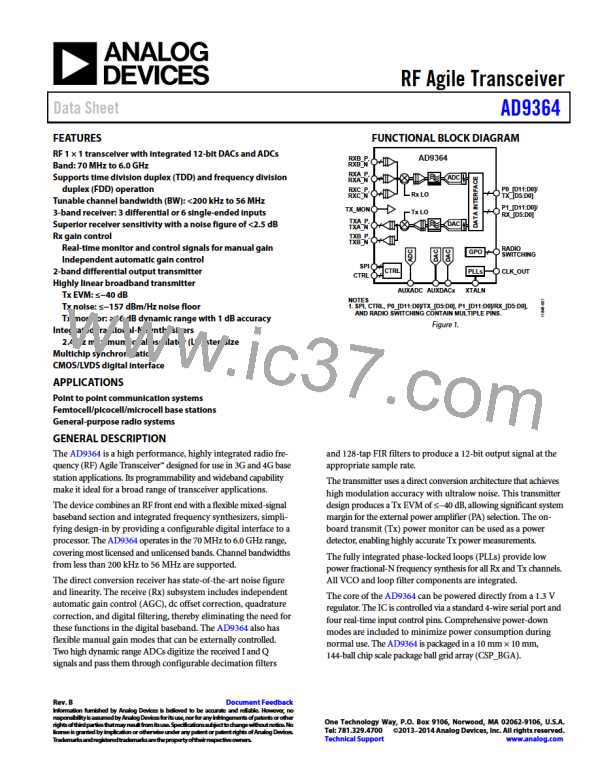Data Sheet
AD9364
RX_FRAME Signal
SYNTHESIZERS
The device generates an RX_FRAME output signal whenever the
receiver outputs valid data. This signal has two modes: level
mode (RX_FRAME stays high as long as the data is valid) and
pulse mode (RX_FRAME pulses with a 50% duty cycle). Similarly,
the BBP must provide a TX_FRAME signal that indicates the
beginning of a valid data transmission with a rising edge. Similar
to the RX_FRAME signal, the TX_FRAME signal can remain
high throughout the burst or it can be pulsed with a 50% duty
cycle.
RF PLLs
The AD9364 contains two identical synthesizers to generate the
required LO signals for the RF signal paths—one for the receiver
and one for the transmitter. Phase-locked loop (PLL) synthesizers
are fractional-N designs incorporating completely integrated
voltage controlled oscillators (VCOs) and loop filters. In TDD
mode, the synthesizers turn on and off as appropriate for the Rx
and Tx frames. In FDD mode, the Tx PLL and the Rx PLL can
be activated at the same time. These PLLs require no external
components.
ENABLE STATE MACHINE
BB PLL
The AD9364 transceiver includes an enable state machine (ENSM)
that allows real-time control over the current state of the device.
The device can be placed in several different states during normal
operation, including
The AD9364 also contains a baseband PLL (BB PLL)
synthesizer that is used to generate all baseband related clock
signals. These include the ADC and DAC sampling clocks, the
DATA_CLK signal (see the Digital Data Interface section), and
all data framing signals. This PLL is programmed from 700 MHz
to 1400 MHz based on the data rate and sample rate requirements
of the system.
• Wait—power save, synthesizers disabled
• Sleep—wait with all clocks/BB PLL disabled
• Tx—Tx signal chain enabled
• Rx—Rx signal chain enabled
DIGITAL DATA INTERFACE
• FDD—Tx and Rx signal chains enabled
• Alert—synthesizers enabled
The AD9364 data interface uses parallel data ports (P0 and P1)
to transfer data between the device and the BBP. The data ports can
be configured in either single-ended CMOS format or differential
LVDS format. Both formats can be configured in multiple arrange-
ments to match system requirements for data ordering and data
port connections. These arrangements include single port data
bus, dual port data bus, single data rate, and double data rate.
The ENSM has two possible control methods: SPI control and
pin control.
SPI Control Mode
In SPI control mode, the ENSM is controlled asynchronously by
writing SPI registers to advance the current state to the next
state. SPI control is considered asynchronous to the DATA_CLK
because the SPI_CLK can be derived from a different clock
reference and can still function properly. The SPI control ENSM
method is recommended when real-time control of the
synthesizers is not necessary. SPI control can be used for real-
time control as long as the BBP has the ability to perform timed
SPI writes accurately.
Bus transfers are controlled using simple hardware handshake
signaling. The two ports can be operated in either bidirectional
(half-duplex) mode or in full duplex mode where half the bits
are used for transmitting data and half are used for receiving data.
The interface can also be configured to use only one of the data
ports for applications that do not require high data rates and
prefer to use fewer interface pins.
Pin Control Mode
DATA_CLK Signal
In pin control mode, the enable function of the ENABLE pin and
the TXNRX pin allow real-time control of the current state. The
ENSM allows TDD or FDD operation depending on the
configuration of the corresponding SPI register. The ENABLE
and TXNRX pin control method is recommended if the BBP
has extra control outputs that can be controlled in real time,
allowing a simple 2-wire interface to control the state of the
device. To advance the current state of the ENSM to the next
state, the enable function of the ENABLE pin can be driven by
either a pulse (edge detected internally) or a level.
The AD9364 supplies the DATA_CLK signal that the BBP uses
when receiving the data. The DATA_CLK signal can be set to a
rate that provides single data rate (SDR) timing where data is
sampled on each rising clock edge, or it can be set to provide
double data rate (DDR) timing where data is captured on both
rising and falling edges. SDR or DDR timing applies to
operation using either a single port or both ports.
FB_CLK Signal
For transmit data, the interface uses the FB_CLK signal as the
timing reference. FB_CLK allows source synchronous timing
with rising edge capture for burst control signals and either
rising edge (SDR mode) or both edge capture (DDR mode) for
transmit signal bursts. The FB_CLK signal must have the same
frequency and duty cycle as DATA_CLK.
When a pulse is used, it must have a minimum pulse width of
one FB_CLK cycle. In level mode, the ENABLE and TXNRX
pins are also edge detected by the AD9364 and must meet the
same minimum pulse width requirement of one FB_CLK cycle.
In FDD mode, the ENABLE and TXNRX pins can be remapped to
serve as real-time Rx and Tx data transfer control signals. In this
mode, the enable function of the ENABLE pin assumes the RXON
Rev. B | Page 29 of 32

 ADI [ ADI ]
ADI [ ADI ]